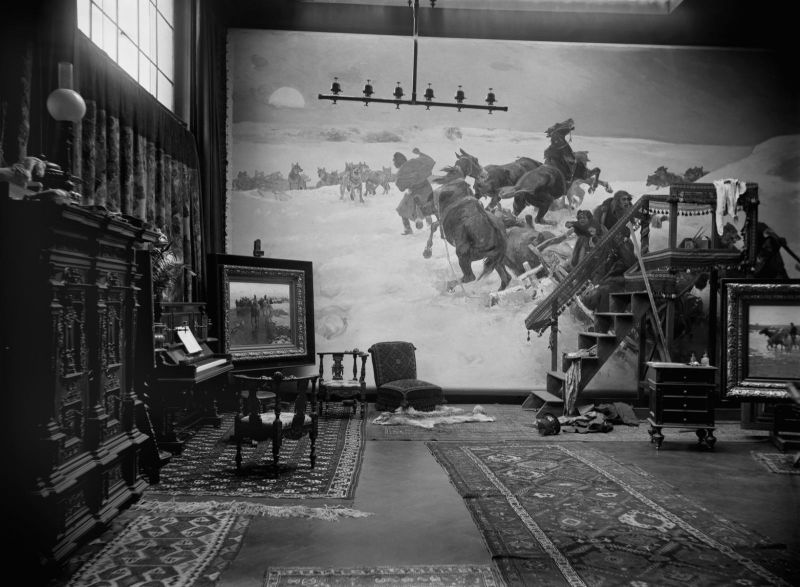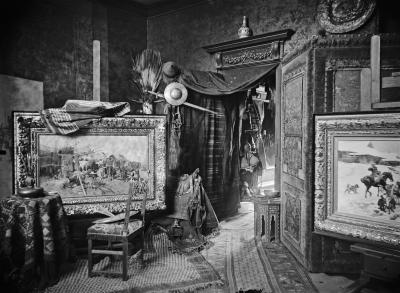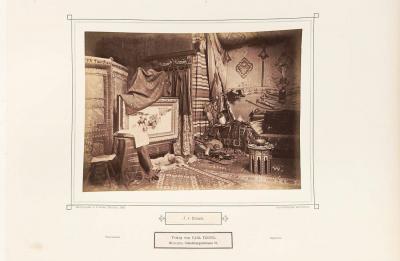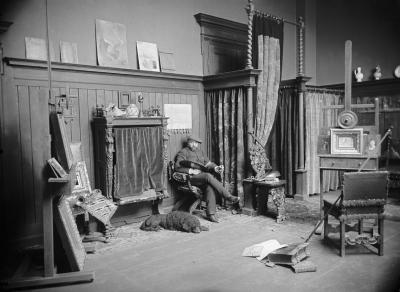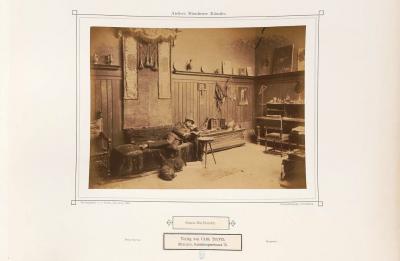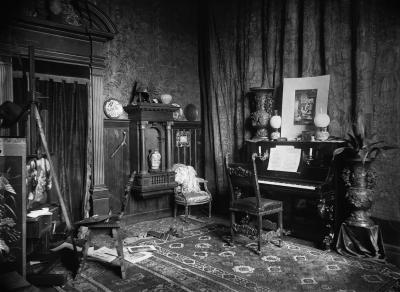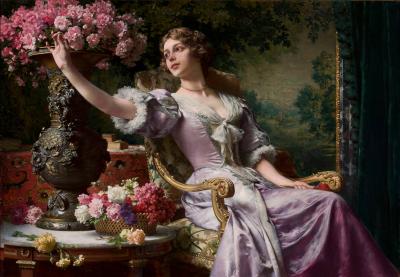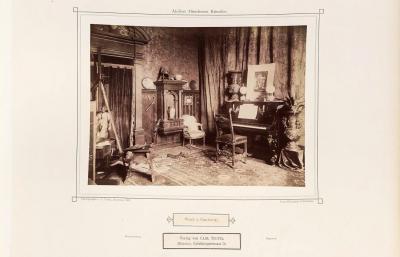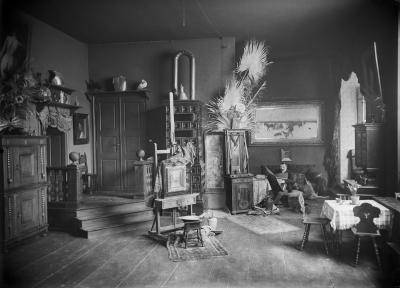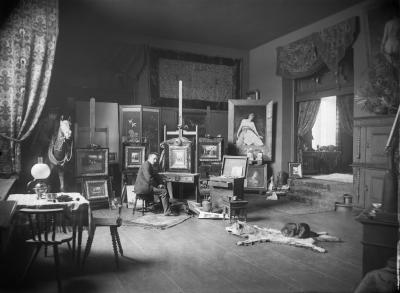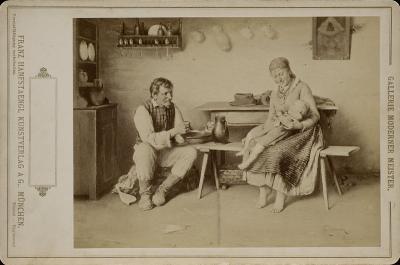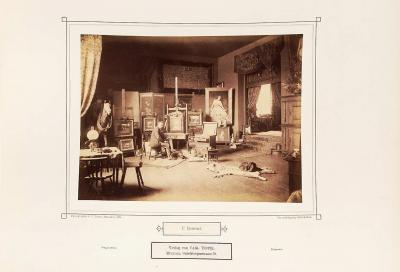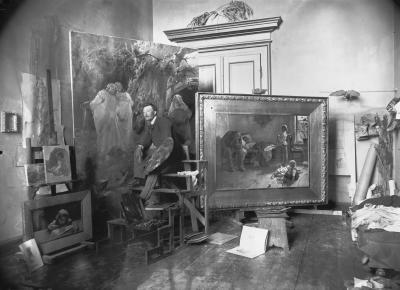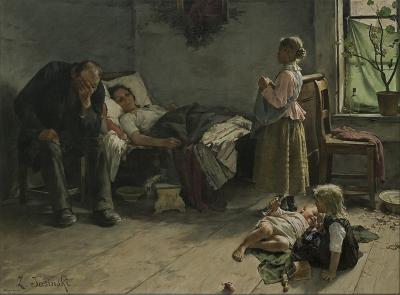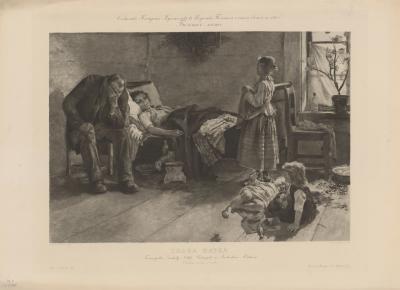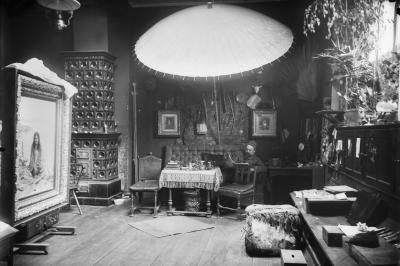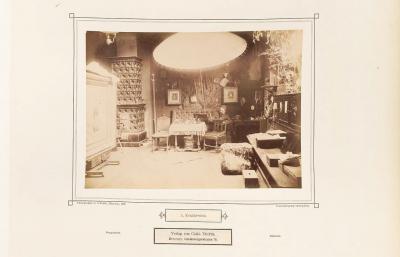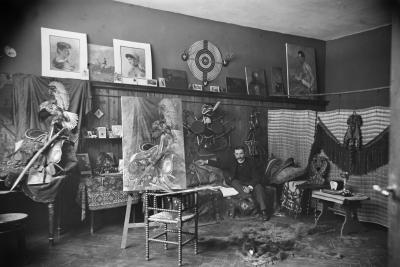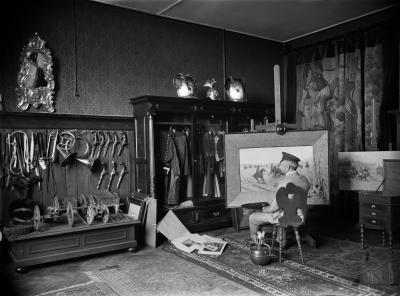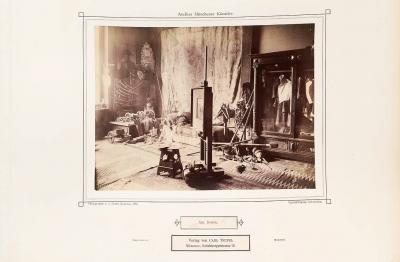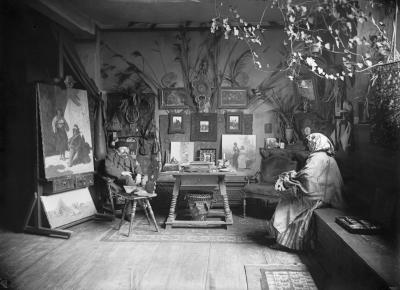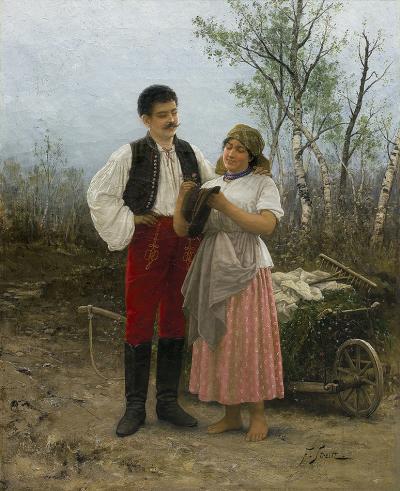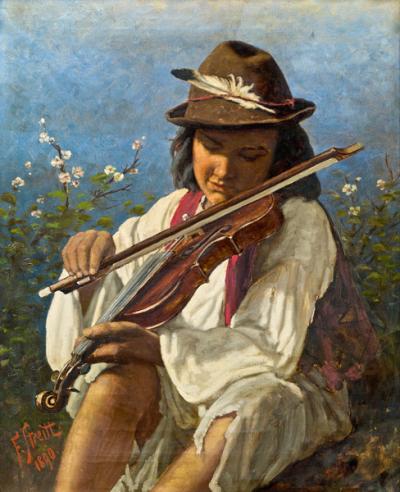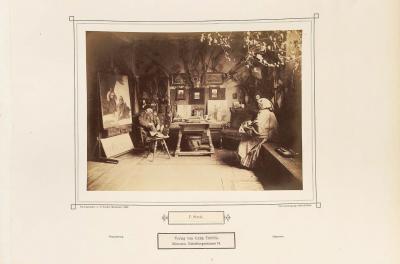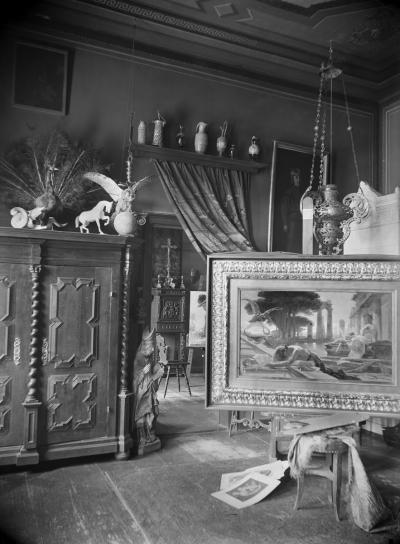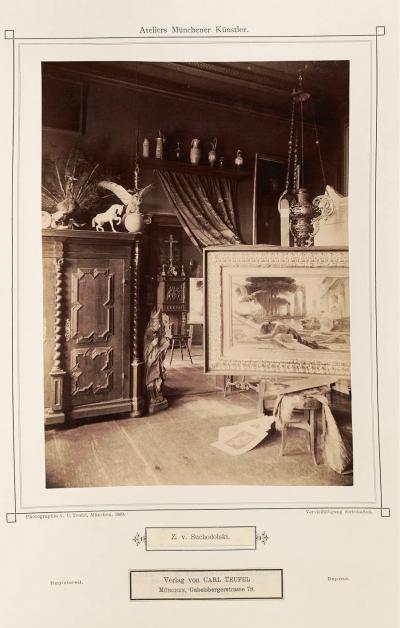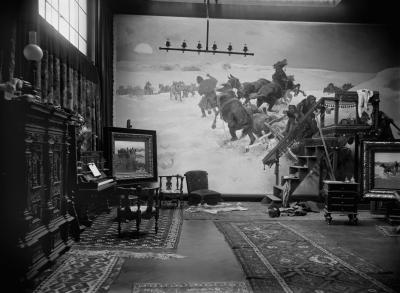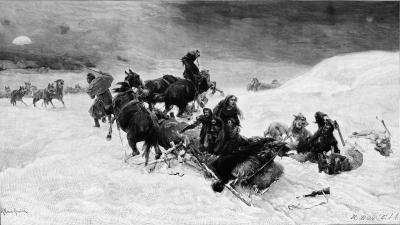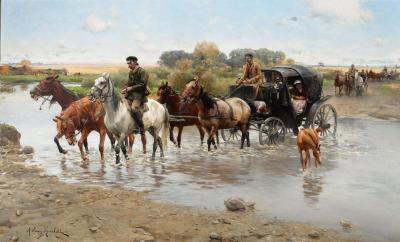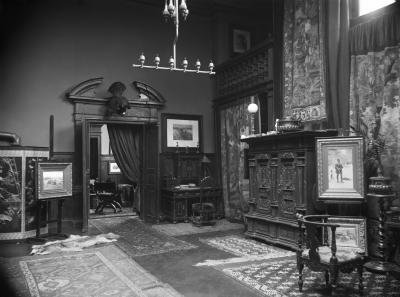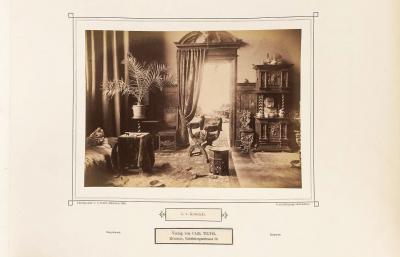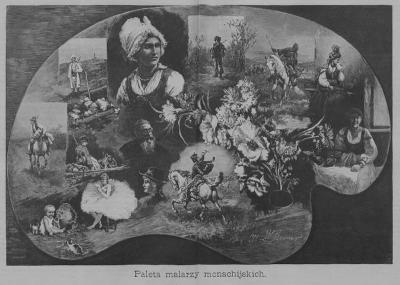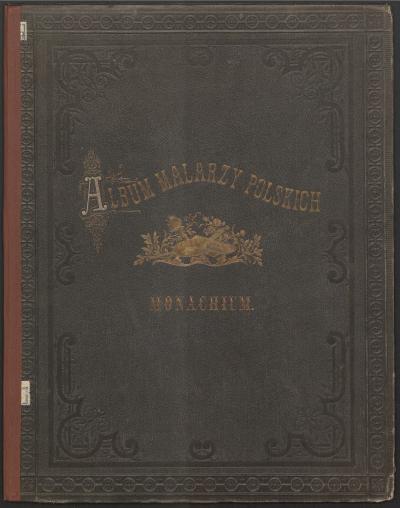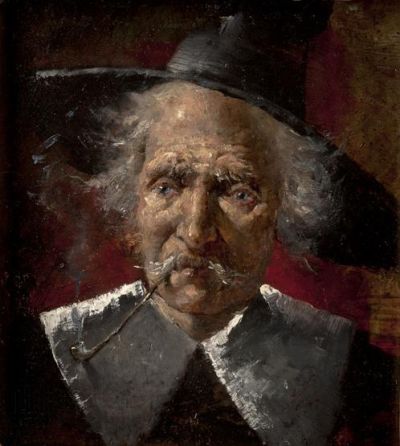Ateliers of Polish painters in Munich ca. 1890
Mediathek Sorted

Suchodolski was not actually a historical painter. Pecht describes him as a “painter of hunting scenes distinguished, in particular, by the fine atmosphere of his pictures”.[99] However, since his time at the Düsseldorf Academy, followed by Italy and then Munich, he devoted himself in particular to religious themes, such as “Saint Cecilia teaches an angel to play the organ/Św. Cecylia ucząca aniołka gry na organach” (1857), “The Judas kiss/Pocałunek Judasza” (1859), “Most Blessed Virgin /Najświętszą Pannę” (1863), “Mother of God/Matkę Boską” (1865), “The vision of Saint Theresa/Wizja św. Teresy” (1876) or “The Three Maji/Trzej królowie” (1903). In his atelier, the effigy of a bishop or saint in the doorway and the home altar in the room behind it are clear indications of the field of painting he specialised in. The painting presented on the easel shows a previously unknown, obviously ancient theme in which a youth has fallen asleep over some writings and papers. The bird shown on the painting bears a remarkable resemblance to the stuffed owl on the Baroque cupboard. Because it is sitting on a globe, the owl could also be the heraldic animal of the Munich Schlaraffia-Vereinigung formed in Neuturmstraße in Munich’s old town in 1880 to cultivate friendship, art and humour. In 1890, the year after Teufel took his photograph, Suchodolski took part in the second Munich Annual Exhibition of Artworks from all Nations in the Glaspalast with his painting “The dreamer”,[100] and in 1893 with an oil painting entitled “Holy Family”.[101] In 1895, his wife, using the name Elisabeth von Suchodolska, exhibited a picture there called “Star Money”, whilst he showed an oil painting entitled “Idyll”.[102] The family remained in Munich. Suchodolski died there in 1908. His son Siegmund von Suchodolski (1875-1935) studied at the School of Arts and Crafts and at the Technical University and worked as an architect, commercial artist and illustrator in Munich.
When Szymon or Simeon or Simon Buchbinder (1853-1908?)[103] came to Munich in 1883, he already had many years of completed art studies and extensive professional experience behind him. From 1869, he studied in the Warsaw Drawing Class/Klasie Rysunkowej under Gerson, Kamiński and Rafał Hadziewicz (1803-1883), he then worked as a decorative painter at the Court Opera in Vienna where he continued his studies at the Art Academy. From 1879 to 1882, he completed a Masters course under Matejko at the Krakow Academy of Fine Arts/Akademia Sztuk Pięknych. Whilst his older brother Józef (1839-1909)[104], who was also a painter, only spent two semesters in Dresden and Munich from 1862 to 1863, Szymon stayed in Munich for fourteen years. The brothers hailed from a Jewish family from the Lublin region. Whilst Józef was baptised under the influence of the Abbey of St Bernard in Łuków, who paid for his artistic training, and turned his hand to Christian motifs and altar painting in Rome and later in Warsaw, Szymon, under the influence of Matejko initially worked on historical themes and then focused on genre motifs from everyday Jewish life. In the Alte Pinakothek in Munich, he studied the Dutch masters of the 17th c,entury (Pecht names Frans van Mieris the Elder and Caspar Netscher)[105] and, whilst in the Bavarian capital, mostly created small-format pictures of figures and interiors in the style of the Dutch Baroque, painting fine art reminiscent of the Old Masters.
Initially residing in Goethestraße, his atelier, as photographed by Teufel (Fig. 3, 4), was at Schwanthalerhöhe 10 in Ludwigsvorstadt on the fourth floor, his private apartment not far from there at Schwanthalerstraße 35 which still bears the same name today.[106] The spacious atelier appears to be a simple work room in which the photographer for want of other decorative motifs draped the mahlstick and some books in the foreground and posed the artist with a palette and brushes. The few objects that served to furnish the atelier were a grandiose curtain, cans and ornamental plates carefully but lovelessly lined up on the mantelpiece, a Renaissance chest that almost all artists seemed to have, and a few musical instruments. Buchbinder was successful artistically and commercially. Along with the other Polish artists, he exhibited his work in the Munich Art Association. His works were talked about positively in the press and he worked, possibly on appointment, for the Munich Galerie Wimmer founded in 1825, which was located at Brienner Straße 3 in the old town and sometimes had access to subsidiaries in London and New York. In 1890, the gallery sold two of his paintings to American art collectors, in 1891 it sold a picture of a young man standing in front of the easel, which only measured 41 x 24 cm, to a collector in New York for 16,000 marks.[107] In 1897, Buchbinder went to Berlin, where he evidently stayed until the end of his life.
[99] Pecht 1888, page 423
[100] Illustrated catalogue of the Munich Annual Exhibition of Artworks of all Nations in the Royal Glaspalaste, Munich 1890, page 39 (see online resources)
[101] Illustrated catalogue of the Munich Annual Exhibition of Artworks of all Nations in the Royal Glaspalaste, Munich 1892, Figure 24
[102] Illustrated catalogue of the Munich Annual Exhibition of Artworks of all Nations in the Royal Glaspalaste, Munich 1895, page 45
[103] Detailed biography in the Encyclopaedia Polonica, https://www.porta-polonica.de/de/lexikon/buchbinder-szymon
[104] Detailed biography in the Encyclopaedia Polonica, https://www.porta-polonica.de/de/lexikon/buchbinder-jozef
[105] Pecht 1888, page 423
[106] Munich address book 1890, Part I, page 44
[107] Jednodniówka 2008, page XVII

















































































